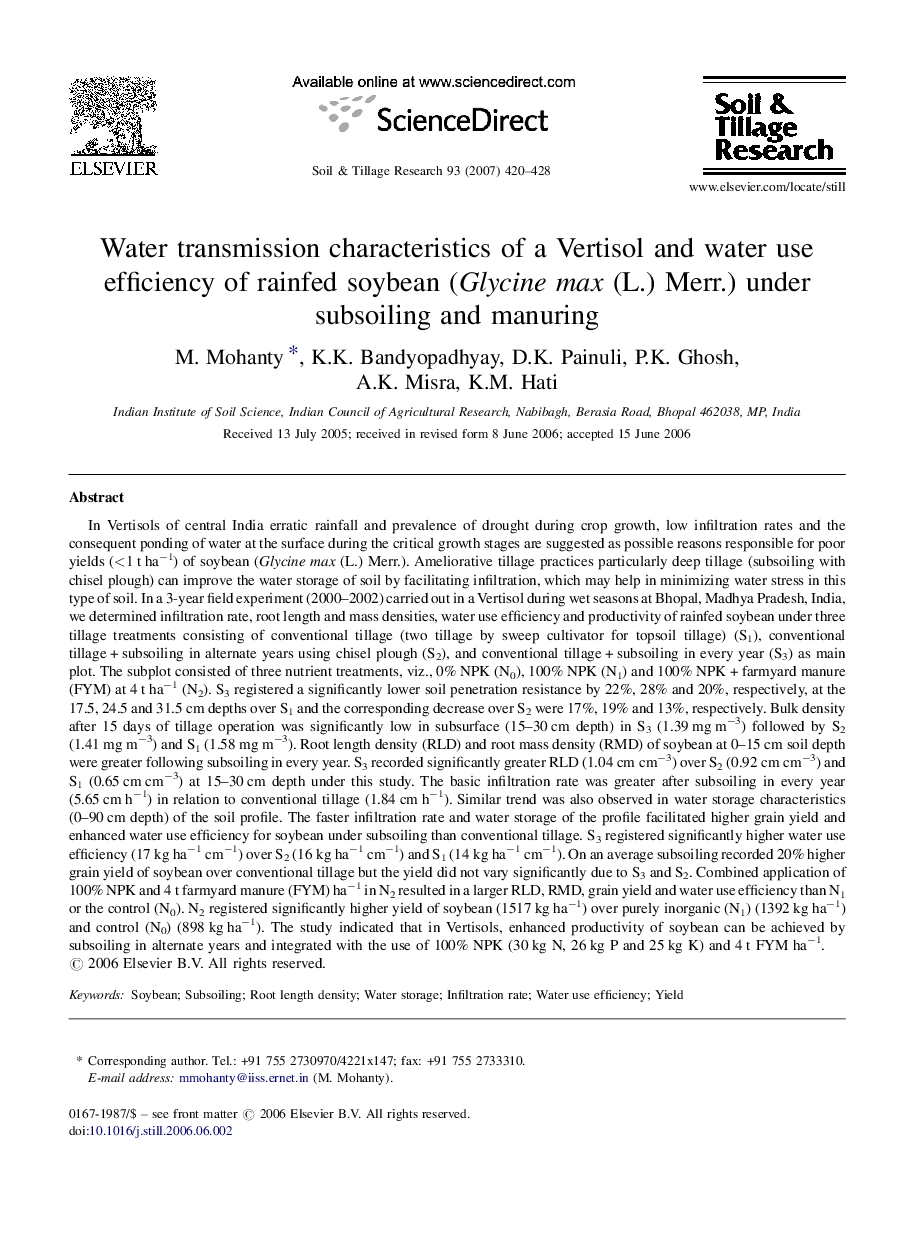| کد مقاله | کد نشریه | سال انتشار | مقاله انگلیسی | نسخه تمام متن |
|---|---|---|---|---|
| 306636 | 513106 | 2007 | 9 صفحه PDF | دانلود رایگان |

In Vertisols of central India erratic rainfall and prevalence of drought during crop growth, low infiltration rates and the consequent ponding of water at the surface during the critical growth stages are suggested as possible reasons responsible for poor yields (<1 t ha−1) of soybean (Glycine max (L.) Merr.). Ameliorative tillage practices particularly deep tillage (subsoiling with chisel plough) can improve the water storage of soil by facilitating infiltration, which may help in minimizing water stress in this type of soil. In a 3-year field experiment (2000–2002) carried out in a Vertisol during wet seasons at Bhopal, Madhya Pradesh, India, we determined infiltration rate, root length and mass densities, water use efficiency and productivity of rainfed soybean under three tillage treatments consisting of conventional tillage (two tillage by sweep cultivator for topsoil tillage) (S1), conventional tillage + subsoiling in alternate years using chisel plough (S2), and conventional tillage + subsoiling in every year (S3) as main plot. The subplot consisted of three nutrient treatments, viz., 0% NPK (N0), 100% NPK (N1) and 100% NPK + farmyard manure (FYM) at 4 t ha−1 (N2). S3 registered a significantly lower soil penetration resistance by 22%, 28% and 20%, respectively, at the 17.5, 24.5 and 31.5 cm depths over S1 and the corresponding decrease over S2 were 17%, 19% and 13%, respectively. Bulk density after 15 days of tillage operation was significantly low in subsurface (15–30 cm depth) in S3 (1.39 mg m−3) followed by S2 (1.41 mg m−3) and S1 (1.58 mg m−3). Root length density (RLD) and root mass density (RMD) of soybean at 0–15 cm soil depth were greater following subsoiling in every year. S3 recorded significantly greater RLD (1.04 cm cm−3) over S2 (0.92 cm cm−3) and S1 (0.65 cm cm−3) at 15–30 cm depth under this study. The basic infiltration rate was greater after subsoiling in every year (5.65 cm h−1) in relation to conventional tillage (1.84 cm h−1). Similar trend was also observed in water storage characteristics (0–90 cm depth) of the soil profile. The faster infiltration rate and water storage of the profile facilitated higher grain yield and enhanced water use efficiency for soybean under subsoiling than conventional tillage. S3 registered significantly higher water use efficiency (17 kg ha−1 cm−1) over S2 (16 kg ha−1 cm−1) and S1 (14 kg ha−1 cm−1). On an average subsoiling recorded 20% higher grain yield of soybean over conventional tillage but the yield did not vary significantly due to S3 and S2. Combined application of 100% NPK and 4 t farmyard manure (FYM) ha−1 in N2 resulted in a larger RLD, RMD, grain yield and water use efficiency than N1 or the control (N0). N2 registered significantly higher yield of soybean (1517 kg ha−1) over purely inorganic (N1) (1392 kg ha−1) and control (N0) (898 kg ha−1). The study indicated that in Vertisols, enhanced productivity of soybean can be achieved by subsoiling in alternate years and integrated with the use of 100% NPK (30 kg N, 26 kg P and 25 kg K) and 4 t FYM ha−1.
Journal: Soil and Tillage Research - Volume 93, Issue 2, April 2007, Pages 420–428